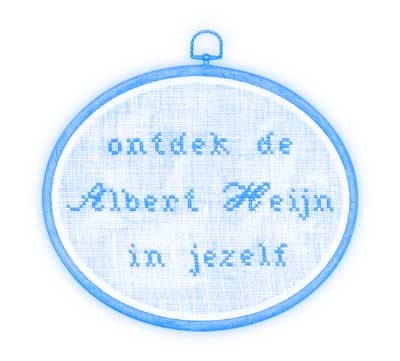Today, this desperate metaphor, which was supposed to express the degeneration and commercialization of our culture, and which brimmed with nostalgic yearning for the illusory better times of the grocer's era, has lost all its critical powers of expression: indeed, it has long become an accepted, everyday reality. At the end of the millennium, the codes of art, of the market, fashion and advertising are profusely and shamelessly running riot, while the museum has lost much of its power as the exclusive arena of what is modern and progressive.
An unexpected and ironical effect of this is that a radically reversed situation can occur, in which the supermarket is no longer a reprehensible or banal cultural symbol, but rather, manifests itself as the perfect space for the contemporary experience. Within the present-day 'experience economy', the supermarket – together with such commercial venues as the department store, shopping mall or theme park – suddenly reflects, better than the static traditional institutes of culture, the most advanced cultural, economic and social concepts: the supermarket as the theatre of topicality, or better still, as a World of Worlds. Needless to say, the visionary Andy Warhol had already foreseen this reversal, judging by his uplifting motto The best museum is a department store.

It tends to be forgotten, but the museum and the department store – the supermarket can be regarded as a variant of the latter – originally had a great deal in common: they came into existence at the same time, during the industrial revolution, in which they fulfilled complementary functions within the new capitalist system, and exchanged display models and theoretic vocabulary. Despite this common origin, the museum, due to the more lofty discourse it had to uphold, is the most frequently used source of reference for the official chronicle of modern culture. But it would certainly also be possible to write such a chronicle, albeit from a different perspective, solely on the basis of the development of the department store and supermarket, places which are governed by the standards and dynamics of everyday life. Of course, Walter Benjamin already made a start, based on the Paris shopping arcade, when he described it as a place where the 'merchandise' had for the first time created a small world of its own. Benjamin characterized these arcades, streets, houses and starlit sky all together, as a 'surrealistic dream'; a dream which he saw shattered by the advent of the electric light, the ban on prostitution, the widening of the pavements, and the open-air cult.
The nineteenth-century shopping arcade as a social tolerance zone recognises late-twentieth-century counterparts in the department store, supermarket and shopping mall: similar in the sense of total, although now fully monitored, worlds, but manifesting themselves rather as hyper-realistic utopias than as surrealistic dreams, and social and public elements are now completely under control. In the Netherlands, far away from the fashionable Paris arcades, began the development of another, originally rather frugal modernity, when in 1887 a certain Albert Heijn opened a grocery shop somewhere in Oostzaan - which still exists today, as a museum: There are three counters in the shop, one of which is authentic, the other two are copies. There are bag holders, chain scales, and an old paraffin lamp. The containers are filled with dried peas and beans, cereals, pearl barley from Alkmaar, vermicelli, flour and rice. The shelves are stocked with such articles as sugar bread, liquorice, peppermint sticks and rennet (...)
1 Museum shop Albert Heijn, www.aheijn.nl/dewereld/fs000038.htm
Pearl barley!
The good old days conjured up here definitively came to an end in 1951, when Albert Heijn, who first had to swallow up his own grocery shop to be able to expand his business, opened his first self-service supermarket. The plain, unadorned shelves of this first supermarket reflected the illusions and visions of an organized world in the virtuous fifties, when things were still – or were finally back – in their proper places, and underlined the success of modern mass production and the collective yearning for material affluence. Now, all these years later, Albert Heijn's World of Worlds – the name of the latest shop concept of this former grocery firm, which, to keep up with the current pace of fashion, has to come up with something different every seven years – bears witness to how quickly things have changed, how nothing is in its place any more, and how shared longings no longer count. In the World of Worlds, it is no longer just about the display and sale of alluring products to a homogenous mass, but rather, about experience, emotion and drama. It makes you wonder how on earth it could have come to this.
The World of Worlds is laid out like a traditional town: a market square (Indulgence Square or Indulgence World L'Aventure) in the middle, surrounded by shops (Convenience World and Shopping World), and on the outskirts an 'industrial area' (Price World). The floor plan and lay-out (architecture, planning principles and lighting) of this superworld 'without prescribed walking direction' are apparently tuned to the individual's environmental perception and the customer's individual behaviour, interpreted by Albert Heijn's corporate sociologists as the dynamic sum of alternating rational and emotional moments and needs. At the centre, 'the throbbing heart of the supermarket', we find emotion in a gourmet 'theatre', with a café, a cookery school, and counters where, without obligation, you can acquire culinary advice and inspiration. Around the centre lies the glittering world of everyday shopping and special offers. The Convenience World with its convenient self-service is the ready-made world for those who want to save themselves time and effort. In the Shopping World, thousands of products are accessibly arranged on the shelves, in displays, and cooled display units. The shopping plan follows the customer's daily routine, his 'eating and drinking moments', from breakfast to apéritif and dinner. Here, you will also find the wine shop, with sommelier. Finally, the Price World is the discount section, all the bargains together in a storeroom-type design.
2 World of Worlds, www.aheijn.nl/dewereld/fs000033.htm
Albert Heijn Homepage, www.ah.nl/
Our deeply rooted urge to go out shopping for food and other necessities of life is thus transformed into a multidimensional experience, which caters not only to economic, but also to social and cultural needs.
3 Interview with the Chief of Store Technology of Albert Heijn, Mr. C.E.H.A.M. van Groeningen, Getronics Group, www.getronics.nl/EE/testimonials/ah/
Driven by his fancy, the ideal consumer according to Albert Heijn moves nimbly from world to world, and perceives shopping as an adventure. In short, the World of Worlds turns the boring but unavoidable task of shopping into an enriching social event, whereby all that which public life in a modern city no longer provides now happens in a covertly controlled manner – the hyper-modernity of this superworld is ultimately conservative in its appeal to a yearning for the lost community spirit. The World of Worlds is a clean and well-guarded total environment, in which Albert Heijn offers tailor-made experiences; all staged, down to the smallest details. In this preconditioned, neutral, and safe world, there are no whores, no foul-smelling vagrants or dog's mess – they are waiting outside, on the pavement.
The Albert Heijn top must have followed one of the seminars of the American 'management strategist' B. Joseph Pine ii, author of The Experience Economy: Work is Theatre & Every Business a Stage, and one of the founders of Strategic Horizons llp, a company that teaches other companies to focus their efforts on the customer's wishes.
4 Joseph Pine II & James Gilmore
The Experience Economy: Work is Theatre & Every Business a Stage Harvard Business School Press 1999 Pine's motto is: Mass customization will be as important in the 21st century as mass production was in the 20th.
5 Interview with B. Joseph Pine II
, by Knowledge Inc, webcom.com/quantera/llpine.html According to Pine, the magic concept of 'mass customization' transforms goods into services and services into 'experiences'. History according to Pine: after the agricultural era, which was based on 'commodities', had changed into a goods-based industrial economy, it was the time of the 'service economy', which in turn has been succeeded by an 'experience economy', whereby consumers no longer primarily demand services, but rather, the experiences that these services can provide.
Pine's shining example in the field of the Experience Economy is, of course, good old Walt Disney, who founded his theme parks, right from the start, on the shared family experience. Entertainment while you dine and theme restaurants are more recent manifestations of the Experience Economy: these, too, focus more on the experience than on the food or service. Mars 2112, for example, a Daroff Design Inc. project, is a space restaurant in New York, where at the entrance visitors are presented with a visa for Mars, and are then taken on a virtual space-shuttle ride to that planet. The restaurant is decorated with craters and lava fountains, and friendly Martians wait on the guests. Such an evening out has come to be called Event Dining. Referring to us, the consumers, Karen Daroff states: They want adventurous experiences in a hyper-immersive, cinematic environment that emotionally, intellectually and physically transports them. If only for a moment, the guests leave their lives behind and become part of the story.
6 Homepage of Daroff Design Inc., www.daroffdesign.com/
According to Pine's doctrine, the sales process is an experience in itself, work is theatre, and every company a stage - pioneer Disney actually calls his employees 'cast members', who are either 'on stage' or 'off stage'. Pine makes a distinction between various kinds of experiences: passive, entertainment-oriented, educational, escapist, and aesthetic. But in his view, the ultimate economic promise has now overtaken the experience and the economy: he has introduced the concept of 'transformation', as a system of experiences which literally changes the customer in one way or another. A Pine-type transformation concerns a reality in which the customer is the product, with the goal being the sale of a transformed, or converted, client. We already knew of this strategy, from the Church; psychology practices, management consultancies and fitness centres can be conceived as more contemporary examples of the 'transformation business', which is in fact aimed at the 'commodification' of the experience and the sale of personal transformations. And what is all this leading to? What you need to do is get to the point where you are actually charging admission just to participate in the process! You can then sell the product at the end of that process, according to the sardonic Pine ii.
7 See note 5
This Experience Economy sheds an even more ecstatic light on the World of Worlds: Albert Heijn is still just not charging for admission to its theatre, but like it or not, time and again we pay the checkout girls, resignedly playing their role, for our own personal transformation. It finally becomes clear that we ourselves are the merchandise, which at least is a totally new perspective. What should we think about how Pine is trying to twist our dealings with ourselves and the merchandise? Is this the product of a subconscious, ice-cold form of cynicism, or that of a brilliantly creative mind? In his sinister novel Times Arrow, in which the action is reversed in time, Martin Amis represents the German concentration camps as places where human beings are produced, rather than exterminated: perhaps it is significant enough that this springs to mind in the context of Pine's ideas.
8 Martin Amis
Times Arrow New York 1992 (reprint)
B. Joseph Pine ii's Experience Economy and Albert Heijn's World of Worlds fit in seamlessly with the present reality culture, in which reality has become show and theme-park fabrication, life a cinematic experience – and vice versa – and in which we ourselves are not only the eternal audience and consumer, but also performers, doomed to wander about among ever changing décors. But the arts actually appear to be the area where the Experience Economy has made the most progress: indeed, in the arts, the point where you are actually charging admission just to participate in the process
9 See note 5
has long been reached. And in the arts, the 'transformation business', including the urge to convert, has of course been functioning since the nineteenth century, when works of art were brought together in museums to represent Truth, Beauty and Goodness.
Significantly enough, the models and vocabulary of the experience economy according to Pine and Albert Heijn have a great deal in common with certain types of contemporary art, which are also aimed explicitly at producing direct experiences and transformations, at linking up with everyday life, and at creating individual and personal contact with the audience. The world of art may like to pretend that in this way it surpasses the commercial market object, but we all know better by now.
The blending together of the categories, of entertainment, art, and economics, completes the circle again. The arts no longer need to uphold anything, they are, once again, what they so dearly wish to be, part of life. On the eve of the twenty-first century, the nineteenth century is finally over. Everything is art, everything is economics. Life is an Albert Heijn supermarket.
translation olivier & wylie
illustrations by Arnoud Holleman en Roel Endendijk
Albert Heijn (ah) is one of the biggest chains of supermarkets in the Netherlands. 

